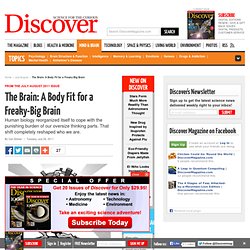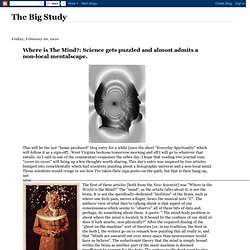

THE BRAIN FROM TOP TO BOTTOM. The Whole Brain Atlas. Brain Atlas - Introduction. The central nervous system (CNS) consists of the brain and the spinal cord, immersed in the cerebrospinal fluid (CSF).

Weighing about 3 pounds (1.4 kilograms), the brain consists of three main structures: the cerebrum, the cerebellum and the brainstem. Cerebrum - divided into two hemispheres (left and right), each consists of four lobes (frontal, parietal, occipital and temporal). The outer layer of the brain is known as the cerebral cortex or the ‘grey matter’. It covers the nuclei deep within the cerebral hemisphere e.g. the basal ganglia; the structure called the thalamus, and the ‘white matter’, which consists mostly of myelinated axons. – closely packed neuron cell bodies form the grey matter of the brain.
Cerebellum – responsible for psychomotor function, the cerebellum co-ordinates sensory input from the inner ear and the muscles to provide accurate control of position and movement. Basal Ganglia Thalamus and Hypothalamus Ventricles Limbic System Reticular Activating System Neurons Glia. The Brain: A Body Fit for a Freaky-Big Brain. Aiello and Wheeler noted that this dramatic increase in brain size would seem to have required a dramatic increase in metabolism—the same way that adding an air-conditioning system to a house would increase the electricity bill.

Yet humans burn the same number of calories, scaled to size, as other primates. Somehow, Aiello and Wheeler argued, our ancestors found a way to balance their energy budget. As they expanded their brains, perhaps they slimmed down other organs. The scientists compared the sizes of organs in humans and other primates. Relatively speaking, our liver is about the same size as a baboon’s. Aiello and Wheeler christened their idea “the expensive tissue hypothesis.” Then William Leonard, a biological anthropologist at Northwestern University, put the expensive tissue hypothesis to a new test. This suggested that the gut-shrinking phenomenon within the primate groups was probably too subtle to explain our increase in brain size completely.
Improve your Brain Health. Where is The Mind?: Science gets puzzled and almost admits a non-local mentalscape. This will be the last "home-produced" blog entry for a while [save the short "Everyday Spirituality" which will follow it as a sign-off] .

West Virginia beckons tomorrow morning and off I will go to whatever that entails. As I said in one of the commentary responses the other day, I hope that reading two journal runs "cover-to-cover" will bring up a few thoughts worth sharing. This day's entry was inspired by two articles bumped into coincidentally which had scientists puzzling about a holographic universe and a non-local mind.
Those scientists would cringe to see how I've taken their sign-posts-on-the-path, but that is their hang-up, not mine. The first of these articles [both from the New Scientist] was "Where in the World is the Mind? " That brings in the second serendipitous article. It reminded me then, also, of a moment when I was able to spend a [too short] time with David Bohm, the famous theoretical physicist. How Does the Brain Retain Info? Exceptional Memory Explained: How Some People Remember What They Had for Lunch 20 Years Ago.
Researchers from the University of California, Irvine reported in 2006 on a woman named Jill Price who could remember in great detail what she did on a particular day decades earlier.

James McGaugh, Larry Cahill and Elizabeth Parker put the woman through a battery of tests and ascertained that she was not using any of the memory tricks that have been known to mnemonists for millennia. Word got out, the media descended and the lab now receives calls every day from people who say they have the same ability as Price. Of the hundreds of people interviewed, 22 appear to exhibit what the researchers call highly superior autobiographical memory (HSAM), the detailed recollection of events that occurred in the distant past. A question that has persisted about this line of research is whether the brains of these people are distinct from the organs of others who can’t remember yesterday’s lunch, let alone trivial events from 20 years back.
Source: University of California, Irvine.